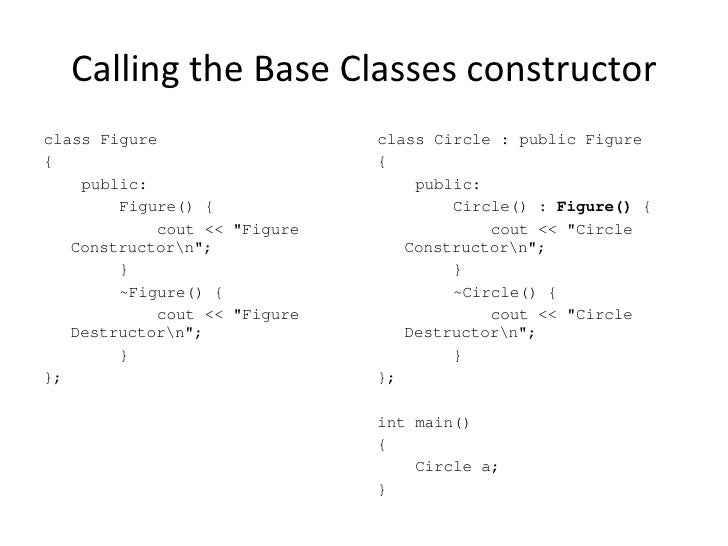

We could declare brain and heart fields, which are common to all animals, in the Animal parent class, and a tail field in the Cat subclass. For example, every animal has a heart and brain, but not every animal has a tail. Why? One reason is to avoid duplicating fields shared between the two classes. To see this, add some console output to the Cat and Animal constructors.

In other words, when creating a Cat object, the Animal constructor is run first, and only afterward is the Cat constructor executed. Only after that constructor is finished does the program execute the constructor of the class corresponding to the object we are creating. It is very important to remember that when an object is created, the constructor of its base class is first called. And if we create a program that simulates a veterinary clinic, it will work with the Animal class (and thus be able to treat both cats and dogs). If the task is to chase after a stick, then we'll use a Dog object. For example, if there is a task to catch mice, we'll create a Cat object in our program. We can declare 2 child classes: Cat and Dog. For example, imagine that we have an Animal class: Several child classes can have one common ancestor. Static constructors must be implemented so that they can be executed in any order.This is called inheritance. The execution order of static constructors is dependent on the program flow.

For this reason, static methods may be executed before the static constructor was ended. That it is called before the class is accessed for the first time.
The point at which the static constructor is called is not fixed. Processing block (dialog module, event block, or procedure) in which the class is accessed. If the class is accessed for the first time only to address a static variable, the static constructor is executed at the beginning of the The static constructor is always called immediately before the class is accessed, with one exception: It is not necessary to execute the static constructor to access a type or a constant of the class. Or a component of the class is used (with the exception of types and constants). The class is accessed when an instance of the class is created The static constructor of a class class is called automatically before theĬlass is accessed for the first time. The static constructor is called once for each class and Unless declared explicitly, the static constructor is merely an empty method. To use the static constructor, the static methodĬlass_constructor must be declared in the public section of the declarationĬLASS-METHODS and implemented in the implementation part. This is a predefined publicĬlass_constructor class. Of the statement CREATE OBJECT are used to pass actual parameters and handle classical exceptions.Įach class has a single static constructor. No exporting parameters shows that constructors only exist to define the state of an object and have The interface is defined using the same syntax as for regular methods in the statement ) in the inheritance).Īn instance constructor can contain an interface with IMPORTING parametersĪnd exceptions. It is not possible to call an instance constructor directly using the constructor(. They are called automatically, immediatelyĪfter an instance is created using the statementĬREATE OBJECT. Instance constructors are called once for each instance. Unless it is declared explicitly, the instance constructor is an implicit method, which inherits and accesses the interface from the instance constructor in the superclass. Here, the most specialized area is recommended. Must be more general or equal to the instantiability defined by the addition CREATE of the statement CLASS. In local classes, the visibility section in which the instance constructor can be declared In globalĬlasses, the instance constructor can be declared in the public visibility section only, for technical Must be declared in a visibility section of the class using the METHODS statement, and implemented in the implementation part. To use the instance constructor, the method constructor This is a predefined instance method of the class calledĬonstructor. These rules are not described in this document, but can be found here.Įach class has one instance constructor. 
Special rules apply to constructors in cases of inheritance. Constructors are necessary when the initial state of an object is to be defined dynamically.Īs in regular methods, there are two types of constructor, namely instance constructors and static constructors.
#Class constructor code#
Typically, constructors have public accessibility so that code outside the class definition or inheritance hierarchy can create objects of the class. You can define as many overloaded constructors as needed to customize initialization in various ways. The state of an object is determined by itsĬontent can be assigned to attributes using the addition VALUE of the statementĭATA. A constructor has the same name as the class and no return value. All rights reserved.Ĭonstructors are special methods that produce a defined initial state for objects and classes. SAP NetWeaver AS ABAP Release 751, ©Copyright 2017 SAP AG.








 0 kommentar(er)
0 kommentar(er)
